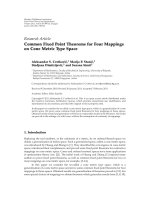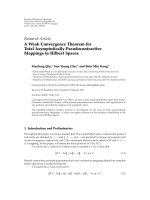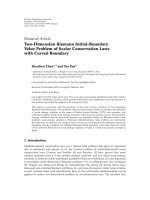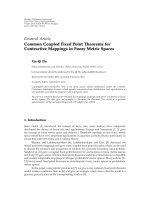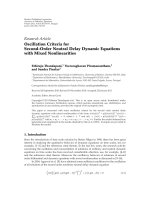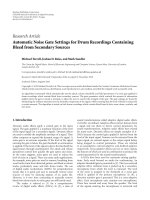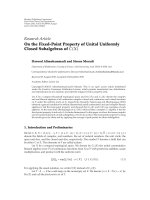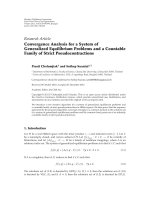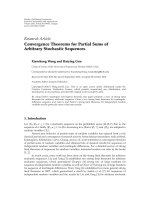Báo cáo hóa học: " Research Article Two-Dimension Riemann Initial-Boundary Value Problem of Scalar Conservation Laws with Curved Boundary" potx
Bạn đang xem bản rút gọn của tài liệu. Xem và tải ngay bản đầy đủ của tài liệu tại đây (702.77 KB, 16 trang )
Hindawi Publishing Corporation
Boundary Value Problems
Volume 2011, Article ID 138396, 16 pages
doi:10.1155/2011/138396
Research Article
Two-Dimension Riemann Initial-Boundary
Value Problem of Scalar Conservation Laws
with Curved Boundary
Huazhou Chen
1, 2
and Tao Pan
2
1
Department of Mathematics, Shanghai University, Shanghai 200444, China
2
Key Laboratory of Optoelectronic Information and Sensing Technologies of Guangdong Higher Educational
Institutes, Jinan University, Guangzhou 510632, China
Correspondence should be addressed to Tao Pan,
Received 16 December 2010; Accepted 1 February 2011
Academic Editor: Julio Rossi
Copyright q 2011 H. Chen and T. Pan. This is an open access article distributed under the Creative
Commons Attribution License, which permits unrestricted use, distribution, and reproduction in
any medium, provided the original work is properly cited.
This paper is concerned with the structure of the weak entropy solutions to two-dimension
Riemann initial-boundary value problem with curved boundary. Firstly, according to the definition
of weak entropy solution in the sense of Bardos-Leroux-Nedelec 1979, the necessary and
sufficient condition of the weak entropy solutions with piecewise smooth is given. The boundary
entropy condition and its equivalent formula are proposed. Based on Riemann initial value
problem, weak entropy solutions of Riemann initial-boundary value problem are constructed,
the behaviors of solutions are clarified, and we focus on verifying that the solutions satisfy the
boundary entropy condition. For different Riemann initial-boundary value data, there are a total
of five different behaviors of weak entropy solutions. Finally, a worked-out specific example is
given.
1. Introduction
Multidimensional conservation laws are a famous hard problem that plays an important
role in mechanics and physics 1–3. For Cauchy problem of multi-dimensional scalar
conservation laws, Conway and Smoller 4 and Kruzkov 1 have proved that weak
solution uniquely exists if it also satisfies entropy condition, and it is called weak entropy
solutions. In order to further understand qualitative behavior of solutions, it is also important
to investigate multi-dimensional Riemann problems. For two-dimensional case, Lindquist
5, Wagner 6, Zhang and Zheng 7 Guckenheimer 8, Zheng 9 among others, have
discussed some relating Riemann problems. In a previous discussion, initial value contains
several constant states with discontinuity lines so that self-similar transformations can be
applied to reduce two-dimensional problem to one-dimensional case. The situation that
2 Boundary Value Problems
initial value contains two constant states divided by a curve can not be solved by selfsimilar
transformations, and Yang 10 proposed a new approach for construction of shock wave
and rarefaction wave solutions; especially, rarefaction wave was got by constructing implicit
function instead of the usual selfsimilar method. This approach can be expanded to general n-
dimension. In addition, multi-dimensional scalar conservation laws with boundary are more
common in practical problems. Bardos et al. 2 have proved the existence and uniqueness
of the weak entropy solution of initial-boundary problems of multi-dimensional scalar
conservation laws. The main difficulty for nonlinear conservation laws with boundary is to
have a good formation of the boundary condition. Namely, for a fixed initial value, we really
can not impose such a condition at the boundary, and the boundary condition is necessarily
linked to the entropy condition. Moreover the behavior of solutions for one-dimensional
problem with boundary was discussed in 11–18. However, for multi-dimensional problem
with boundary, the behaviors of solutions are still hard to study.
In this paper, two-dimensional case as an example of Yang’s multi-dimensional
Riemann problem 10 is expanded to the case with boundary. Considering two-dimensional
Riemann problem for scalar conservation laws with curved boundary,
u
t
∂f
1
u
∂x
1
∂f
2
u
∂x
2
0,
x
1
,x
2
∈ Ω,t>0,
u|
t0
u
,
x
1
,x
2
∈ Ω,
u|
Γ
u
−
,t>0,
1.1
where u ut, x
1
,x
2
, u
and u
−
are both constants, f
1
u,f
2
u ∈ C
2
R, Mx
1
,x
2
∈ C
1
R
2
,
Mx
1
,x
2
0 is a smooth manifold and divides R
2
into two infinite parts, Ω{x
1
,x
2
|
Mx
1
,x
2
> 0},andΓ{t, x
1
,x
2
| Mx
1
,x
2
0,t>0} and denote u|
Γ
γu.
In Section 2, weak entropy solution of Riemann initial-boundary value problem 1.1
is defined, and the boundary entropy condition is discussed. In Section 3, weak entropy
solutions of the corresponding Riemann initial value problem are expressed. In Section 4,
using the weak entropy solutions of the corresponding Riemann initial value problem, we
construct the weak entropy solutions of Riemann initial-boundary value problem, and prove
that they satisfy the boundary entropy condition. The weak entropy solutions include a
total of five different shock and rarefaction wave solutions based on different Riemann data.
Finally, in Section 5, we give a worked-out specific example.
2. Preliminaries
According to the definition of the weak entropy solution and the boundary entropy condition
to the general initial-boundary problems of multi-dimensional scalar conservation laws
which was proposed by Bardos et al. 2 and Pan and Lin 13, we can obtain the following
definition and three lemmas for Riemann initial-boundary value problem 1.1.
Definition 2.1. A locally bounded and bounded variation function ut, x
1
,x
2
on 0, ∞ × Ω
is called a weak entropy solution of Riemann initial-boundary value problem 1.1 if, for any
real constant k and for any nonnegative function ϕt, x
1
,x
2
∈ C
∞
0
0, ∞ × Ω,itsatisfies
Boundary Value Problems 3
the following inequality:
∞
0
M>0
|
u − k
|
ϕ
t
sgn
u − k
f
1
u
− f
1
k
ϕ
x
1
sgn
u − k
f
2
u
− f
2
k
ϕ
x
2
× dx
1
dx
2
dt
M>0
|
u
− k
|
ϕ
0,x
1
,x
2
dx
1
dx
2
Γ
sgn
u
−
− k
f
1
γu
− f
1
k
,f
2
γu
− f
2
k
◦ nγϕdx
1
dx
2
dt ≥ 0,
2.1
where n is the outward normal vector of curve Mx
1
,x
2
.
Lemma 2.2. If ut, x
1
,x
2
is a weak entropy solution of 1.1, then it satisfies the following boundary:
entropy condition
sgn
γu− u
−
f
1
γu
− f
1
k
,f
2
γu
− f
2
k
◦ n ≥ 0,k∈ I
γu,u
−
, a.e. t>0, 2.2
where Iγu,u
−
minγu,u
−
, maxγu,u
−
.
It can be easily proved that ∀k ∈ Iγu,u
−
, sgnγu − u
−
sgnγu − k,so2.2 can be
rewritten as
sgn
γu− k
f
1
γu
− f
1
k
,f
2
γu
− f
2
k
◦ n ≥ 0,k∈ I
γu,u
−
, a.e. t>0, 2.3
thus one can get γu u
−
or
n ◦
f
1
γu
− f
1
k
γu− k
,
f
2
γu
− f
2
k
γu− k
≥ 0,k∈ I
γu,u
−
,k
/
γu, a.e. t>0, 2.4
and one notices that n −M
x
1
, −M
x
2
, M
x
1
∂Mx
1
,x
2
/∂x
1
,M
x
2
∂Mx
1
,x
2
/∂x
2
,then
boundary entropy condition 2.2 is equivalent to
γu u
−
or
M
x
1
f
1
γu
− f
1
k
γu− k
M
x
2
f
2
γu
− f
2
k
γu− k
≤ 0,k∈ I
γu,u
−
,k
/
γu, a.e. t>0.
2.5
The proof for one-dimension case of Lemma 2.2 can be found in Pan and Lin’s work
13, and the proof for n-dimension case is totally similar to one-dimension case; actually the
idea of the proof first appears in Bardos et al.’s work 2, so the proof details for Lemma 2.2
are omitted here.
Lemma 2.3. A piecewise smooth function ut, x
1
,x
2
with smooth discontinuous surface is a weak
entropy solution to the Riemann initial-boundary value problem 1.1 in the sense of 2.1 if and only
if the following conditions are satisfied.
4 Boundary Value Problems
(i) Rankine-Hugoniot condition: At any point P on discontinuity surface
S of solution
ut, x
1
,x
2
,
N
P
is a unit normal vector to S at P if
u
r
lim
ε →0
u
P εn
,
u
l
lim
ε →0
−
u
P εn
,
2.6
then
N
P
◦
u
,
f
1
,
f
2
0, 2.7
where uu
r
− u
l
, f
1
f
1
u
r
− f
1
u
l
, f
2
f
2
u
r
− f
2
u
l
.
For any constant k ∈ u
l
,u
r
, P ∈ S,
N
P
◦
k − u
l
,f
1
k
− f
1
u
l
,f
2
k
− f
2
u
l
≥ 0
2.8
or equivalently
N
P
◦
k − u
r
,f
1
k
− f
1
u
r
,f
2
k
− f
2
u
r
≥ 0.
2.9
(ii) Boundary entropy condition:
γu u
−
or
M
x
1
f
1
γu
− f
1
k
γu− k
M
x
2
f
2
γu
− f
2
k
γu− k
≤ 0,k∈ I
γu,u
−
,k
/
γu, a.e. t>0.
2.10
(iii) Initial value condition:
u
0,x
1
,x
2
u
0
x
1
,x
2
,M
x
1
,x
2
> 0. 2.11
For piecewise smooth solution with smooth discontinuous surface, Rankine-Hugoniot
condition 2.7, entropy conditions 2.8, 2.9 and initial value condition 2.11 are obviously
satisfied, see also the previous famous works in 4, 7–9.AsinLemma 2.2, boundary entropy
condition 2.10 also holds. The proof of the converse in not difficult and is omitted here.
According to Bardos et al.’s work 2, we have the following Lemma.
Lemma 2.4. If ut, x
1
,x
2
is piecewise smooth weak entropy solution of 1.1 which satisfies the
conditions of Lemma 2.3,thenut, x
1
,x
2
is unique.
According to the uniqueness of weak entropy solution, as long as the piecewise smooth
function satisfying Lemma 2.3 is constructed, the weak entropy solution of Riemann initial-
boundary value problem can be obtained.
Boundary Value Problems 5
3. Solution of Riemann Initial Value Problem
First, we study the Riemann initial value problem corresponding to the Riemann initial-
boundary value problem 1.1 as follows:
u
t
∂f
1
u
∂x
1
∂f
2
u
∂x
2
0,t>0,
u|
t0
⎧
⎨
⎩
u
−
,M
x
1
,x
2
< 0
u
,M
x
1
,x
2
> 0.
3.1
Condition H For u ∈ a, b,
M
x
1
f
1
u
M
x
2
f
2
u
> 0, 3.2
where a, b is a certain interval a, b can be a finite number or ∞.
Condition H combines flux functions f
1
,f
2
and curved boundary manifold M,
providing necessary condition for the convex property of the new flux function which will
be constructed in formula 4.5. The convex property clarifies whether the characteristics
intersect or not, whether the weak solution satisfied internal entropy conditions 2.8 and
2.9 and boundary entropy condition 2.10, In addition, Condition H is easily satisfied, for
example, f
1
uf
2
u1/2u
2
, Mx
1
,x
2
x
3
1
x
2
, then M
x
1
f
1
uM
x
2
f
2
u3x
2
1
1 > 0,
so Condition Hholds. Here Mx
1
,x
2
0 is a cubic curve on the X
1
-X
2
plane, and it is strictly
bending.
Yang’s work 10 showed that depending on whether the characteristics intersect or
not, the weak entropy solution of 3.1 has two forms as follows.
Lemma 3.1 see 10. Suppose (H) holds. If u
−
>u
, then weak entropy solution of 3.1 is shock
wave solution S, and
u
t, x
1
,x
2
⎧
⎪
⎪
⎪
⎪
⎪
⎨
⎪
⎪
⎪
⎪
⎪
⎩
u
−
,M
x
1
−
f
1
u
t, x
2
−
f
2
u
t
< 0,
u
,M
x
1
−
f
1
u
t, x
2
−
f
2
u
t
> 0,
3.3
and discontinuity surface
St, x
1
,x
2
0 is
M
x
1
−
f
1
u
t, x
2
−
f
2
u
t
0, 3.4
where uu
− u
−
, f
1
f
1
u
− f
1
u
−
,f
2
f
2
u
− f
2
u
−
.
6 Boundary Value Problems
Lemma 3.2 see 10. Suppose that (H) holds. If u
−
<u
, then weak entropy solution of 3.1 is
rarefaction wave solution R, and
u
t, x
1
,x
2
⎧
⎪
⎪
⎪
⎪
⎪
⎪
⎪
⎨
⎪
⎪
⎪
⎪
⎪
⎪
⎪
⎩
u
−
, 0 >M
x
1
− f
1
u
−
t, x
2
− f
2
u
−
t
,t>0,
C
t, x
1
,x
2
,M
x
1
− f
1
u
−
t, x
2
− f
2
u
−
t
≥ 0
≥ M
x
1
− f
1
u
t, x
2
− f
2
u
t
,t>0,
u
,M
x
1
− f
1
u
t, x
2
− f
2
u
t
> 0,t>0,
3.5
where Ct, x
1
,x
2
is the implicit function which satisfies
M
x
1
− f
1
C
t, x
2
− f
2
C
t
0. 3.6
Theorem 3.3 see 10. Suppose that (H) holds. Given u
−
,u
∈ a, b,then
i if u
−
>u
, weak entropy solution of 3.1 is S and ut, x
1
,x
2
has a form as 3.3;
ii if u
−
<u
, weak entropy solution of 3.1 is R and ut, x
1
,x
2
has a form as 3.5;
iii weak entropy solutions formed as 3.3 and 3.5 uniquely exist.
The weak entropy solutions constructed here are piecewise smooth and satisfy conditions (i)
and (iii) of Lemma 2.3.
4. Solution of Riemann Initial-Boundary Value Problem
Now we restrict the weak entropy solutions of the Riemann initial value problem 3.1
constructed in Section 3 in region {t>0}×Ω, and they still satisfy conditions i and iii
of Lemma 2.3. If they also satisfy the boundary entropy condition ii of Lemma 2.3, then
they are the weak entropy solutions of Riemann initial-boundary value problem 1.1.
Based on different Riemann data of u
and u
−
, the weak entropy solutions of the
Riemann initial value problem 3.1 have the following five different behaviors when
restricted in region {t>0}×Ω.
If u
−
>u
, the solution of 3.1 is shock wave S and
u
t, x
1
,x
2
⎧
⎪
⎪
⎪
⎪
⎪
⎨
⎪
⎪
⎪
⎪
⎪
⎩
u
−
,M
x
1
−
f
1
u
t, x
2
−
f
2
u
t
< 0,M
x
1
,x
2
> 0,t>0,
u
,M
x
1
−
f
1
u
t, x
2
−
f
2
u
t
> 0,M
x
1
,x
2
> 0,t>0.
4.1
Mx
1
− f
1
/ut, x
2
− f
2
/ut0 is formed by moving Mx
1
,x
2
0along
the direction of the vector f
1
/u, f
2
/u f
1
u
− f
1
u
−
/u
− u
−
, f
2
u
−
f
2
u
−
/u
− u
−
α, and the outward normal vector n of curve Mx
1
,x
2
0 is equal to
−M
x
1
, −M
x
2
. According to the angle between α and n, the solution restricted in {t>0}×Ω
has two behaviors as follows.
Case 1. If u
−
>u
and n ◦ f
1
/u, f
2
/u ≥ 0.
Boundary Value Problems 7
Mx
1
−
f
1
u/u
t, x
2
−
f
2
u/u
t0,t>0
u−
Mx
1
,x
2
0,t>0
u
−
u
Mx
1
,x
2
0
t
x
2
x
1
a The constant solution
u
Fu
u
∗
,Fu
∗
u
−
,Fu
−
k, Fk
ru, Fru
b The phase plane u, Fu
Figure 1: Case 1.
Mx
1
−
f
1
u/u
t, x
2
−
f
2
u/u
t0,t>0
u
−
Mx
1
,x
2
0,t>0
u
−
u
Mx
1
,x
2
0
t
x
2
x
1
Figure 2: The shock wave solution of Case 2.
See also Figure 1a; it shows that the angle between α and n is an acute angle, the
shock wave surface Mx
1
−f
1
/ut, x
2
−f
2
/ut0 is outside region {t>0}×Ω,and
the solution is constant state formed as
u
t, x
1
,x
2
u
,M
x
1
,x
2
≥ 0,t>0. 4.2
Case 2. If u
−
>u
and n ◦ f
1
/u, f
2
/u < 0.
8 Boundary Value Problems
See also Figure 2; it shows that the angle between α and n is an obtuse angle, the shock
wave surface Mx
1
− f
1
/ut, x
2
− f
2
/ut0 is inside region {t>0}×Ω,andthe
solution is shock wave formed as
u
t, x
1
,x
2
⎧
⎪
⎪
⎪
⎪
⎪
⎨
⎪
⎪
⎪
⎪
⎪
⎩
u
−
,M
x
1
,x
2
> 0 >M
x
1
−
f
1
u
t, x
2
−
f
2
u
t
,t>0
u
,M
x
1
−
f
1
u
t, x
2
−
f
2
u
t
> 0,t>0.
4.3
If u
−
<u
, the solution of 3.1 is rarefaction wave R and
u
t, x
1
,x
2
⎧
⎪
⎪
⎪
⎪
⎪
⎪
⎪
⎪
⎪
⎪
⎪
⎪
⎪
⎪
⎪
⎪
⎪
⎨
⎪
⎪
⎪
⎪
⎪
⎪
⎪
⎪
⎪
⎪
⎪
⎪
⎪
⎪
⎪
⎪
⎪
⎩
u
−
,M
x
1
− f
1
u
−
t, x
2
− f
2
u
−
t
< 0,
M
x
1
,x
2
> 0,t>0,
C
t, x
1
,x
2
,M
x
1
− f
1
u
−
t, x
2
− f
2
u
−
t
≥ 0,
M
x
1
− f
1
u
t, x
2
− f
2
u
t
≤ 0,
M
x
1
,x
2
> 0,t>0,
u
,M
x
1
− f
1
u
t, x
2
− f
2
u
t
> 0,
M
x
1
,x
2
> 0,t>0.
4.4
Mx
1
−f
1
u
−
t, x
2
−f
2
u
−
t0 is formed by moving Mx
1
,x
2
0 along the direction
of the vector f
1
u
−
,f
2
u
−
β
−
, Mx
1
− f
1
u
t, x
2
− f
2
u
t0 is formed by moving
Mx
1
,x
2
0 along the direction of the vector f
1
u
,f
2
u
β
, and the outward normal
vector n of curve Mx
1
,x
2
0 is equal to −M
x
1
, −M
x
2
.
We construct a new flux function
f
x
1
,x
2
,u
M
x
1
f
1
u
M
x
2
f
2
u
F
u
,
4.5
according to condition H, F
uM
x
1
f
1
uM
x
2
f
2
u > 0, Fu is convex, and F
u is
monotonically increasing function, so F
u
−
<F
u
. And also
F
u
−
M
x
1
f
1
u
−
M
x
2
f
2
u
−
−n ◦
f
1
u
−
,f
2
u
−
,
F
u
M
x
1
f
1
u
M
x
2
f
2
u
−n ◦
f
1
u
,f
2
u
.
4.6
Thus, n ◦ f
1
u
−
,f
2
u
−
>n ◦ f
1
u
,f
2
u
. According to the angles between
β
,
β
−
,and
n, the solution restricted in {t>0}×Ω has three behaviors as follows.
Case 3. If u
−
<u
and n ◦ f
1
u
,f
2
u
<n ◦ f
1
u
−
,f
2
u
−
≤ 0.
Boundary Value Problems 9
Mx
1
− f
1
u
−
t, x
2
− f
2
u
−
t0,t>0
u
−
Mx
1
,x
2
0,t>0
u
−
u
Mx
1
,x
2
0
Mx
1
− f
1
u
t, x
2
− f
2
u
t0,t>0
t
x
2
x
1
Figure 3: The rarefaction wave solution of Case 3.
See also Figure 3; it shows that the angles between
β
,
β
−
, and n are obtuse angles, the
rarefaction wave surfaces Mx
1
−f
1
u
t, x
2
−f
2
u
t0andMx
1
−f
1
u
−
t, x
2
−f
2
u
−
t0
are both inside region {t>0}×Ω, and the solution is rarefaction wave formed as
u
t, x
1
,x
2
⎧
⎪
⎪
⎪
⎪
⎪
⎪
⎪
⎨
⎪
⎪
⎪
⎪
⎪
⎪
⎪
⎩
u
−
,M
x
1
,x
2
> 0 >M
x
1
− f
1
u
−
t, x
2
− f
2
u
−
t
,t>0,
C
t, x
1
,x
2
,M
x
1
− f
1
u
−
t, x
2
− f
2
u
−
t
≥ 0
≥ M
x
1
− f
1
u
t, x
2
− f
2
u
t
,t>0,
u
,M
x
1
− f
1
u
t, x
2
− f
2
u
t
> 0,t>0,
4.7
where Ct, x
1
,x
2
is the implicit function which satisfies 3.6.
Case 4. If u
−
<u
and n ◦ f
1
u
,f
2
u
< 0 <n ◦ f
1
u
−
,f
2
u
−
.
See also Figure 4a; it shows that the angle between
β
and n is an obtuse angle, the
angle between
β
−
and n is an acute angles, the rarefaction wave surface Mx
1
− f
1
u
t, x
2
−
f
2
u
t0 is inside region {t>0}×Ω, the rarefaction wave surface Mx
1
− f
1
u
−
t, x
2
−
f
2
u
−
t0 is outside region {t>0}×Ω, and the solution is rarefaction wave formed as
u
t, x
1
,x
2
⎧
⎨
⎩
C
t, x
1
,x
2
,M
x
1
,x
2
> 0 ≥ M
x
1
− f
1
u
t, x
2
− f
2
u
t
,t>0,
u
,M
x
1
− f
1
u
t, x
2
− f
2
u
t
> 0,t>0,
4.8
where Ct, x
1
,x
2
is the implicit function which satisfies 3.6.
Case 5. If u
−
<u
and 0 ≤ n ◦f
1
u
,f
2
u
<n ◦ f
1
u
−
,f
2
u
−
.
10 Boundary Value Problems
Mx
1
− f
1
u
−
t, x
2
− f
2
u
−
t0,t>0
u
−
Mx
1
,x
2
0,t>0
u
−
u
Mx
1
,x
2
0
Mx
1
− f
1
u
t, x
2
− f
2
u
t0,t>0
t
x
2
x
1
a The rarefaction wave solution
u
Fu
ru, Fru u
∗
,Fu
∗
u
−
,Fu
−
k, Fk
b The phase plane u, Fu
Figure 4: Case 4.
See also Figure 5a; it shows that the angles between
β
,
β
−
,andn are acute angles, the
rarefaction wave surfaces Mx
1
−f
1
u
t, x
2
−f
2
u
t0andMx
1
−f
1
u
−
t, x
2
−f
2
u
−
t0
are both outside region {t>0}×Ω, and the solution is constant state formed as
u
t, x
1
,x
2
u
,M
x
1
,x
2
> 0,t>0. 4.9
Next, we verify the above five solutions all satisfying the boundary entropy condition
ii of Lemma 2.3. By noticing the definition of Fu4.5 and its convex property, the
boundary entropy condition ii of Lemma 2.3 can be equivalent to the following formula
γu u
−
or
F
γu
− F
k
γu− k
≤ 0,k∈ I
γu,u
−
,k
/
γu, a.e. t>0, 4.10
and thus we verify the above five solutions all satisfying the boundary entropy condition
4.10.
Case 1. When u
−
>u
, n ◦f
1
/u, f
2
/u ≥ 0, the shock wave solution is formed as 4.2.
In this case, γu u
/
u
−
since
F
γu
− F
u
−
γu− u
−
−n ◦
f
1
u
,
f
2
u
≤ 0
see also Figure 1
b
, 4.11
and γu < u
−
≤ u
∗
, where u
∗
is the extreme point of Fu. For ∀k ∈ γu,u
−
, according to the
convex property of Fu, we have that
F
γu
− F
k
γu− k
≤
F
γu
− F
u
−
γu− u
−
≤ 0,
4.12
and so the boundary entropy condition 4.10 is verified.
Boundary Value Problems 11
Mx
1
− f
1
u
−
t, x
2
− f
2
u
−
t0,t>0
u
−
Mx
1
,x
2
0,t>0
u
−
u
Mx
1
,x
2
0
Mx
1
− f
1
u
t, x
2
− f
2
u
t0,t>0
t
x
2
x
1
a The constant solution
u
Fu
u
∗
,Fu
∗
ru, Fru
u
−
,Fu
−
k, Fk
b The phase plane u, Fu
Figure 5: Case 5.
Case 2. When u
−
>u
, n ◦f
1
/u, f
2
/u < 0, the shock wave solution is formed as 4.3.
In this case, γu u
−
, so the boundary entropy condition 4.10 is naturally verified.
Case 3. When u
−
<u
, n ◦ f
1
u
,f
2
u
<n ◦ f
1
u
−
,f
2
u
−
≤ 0, the rarefaction wave
solution is formed as 4.7. In this case, γu u
−
, and so the boundary entropy condition
4.10 is naturally verified.
Case 4. When u
−
<u
, n ◦ f
1
u
,f
2
u
< 0 <n ◦ f
1
u
−
,f
2
u
−
, the rarefaction wave
solution is formed as 4.8. In this case, γu Ct, x
1
,x
2
|
Mx
1
,x
2
0
u
∗
≤ u
−
, F
u
∗
0and
F
u
−
−n ◦ f
1
u
−
,f
2
u
−
< 0 < −n ◦ f
1
u
,f
2
u
F
u
see also Figure 4b,
namely, F
u
−
<F
γu0 <F
u
. For ∀k ∈ u
−
,γu, according to the convex property of
Fu and Lagrange mean value theorem, there exists ξ ∈ k, γu, satisfying
F
γu
− F
k
γu− k
F
ξ
≤ F
γu
0,
4.13
and so the boundary entropy condition 4.10 is verified.
Case 5. When u
−
<u
,0≤ n ◦ f
1
u
,f
2
u
<n ◦ f
1
u
−
,f
2
u
−
, the rarefaction wave
solution is formed as 4.9. In this case, γu u
>u
−
since F
u
−
−n ◦ f
1
u
−
,f
2
u
−
<
−n ◦ f
1
u
,f
2
u
F
γu ≤ 0 see also Figure 5b For ∀k ∈ u
−
,γu, according to the
convex property of Fu and Lagrange mean value theorem, there exists ξ ∈ k, γu, satisfying
F
γu
− F
k
γu− k
F
ξ
≤ F
γu
≤ 0,
4.14
and so the boundary entropy condition 4.10 is verified.
12 Boundary Value Problems
In summary, we have the following theorem.
Theorem 4.1. Suppose that (H) holds. Given u
−
,u
∈ a, b,then
i if u
−
>u
and n ◦f
1
/u, f
2
/u ≥ 0, the solution of 1.1 is constant state and has
form as 4.2,
ii if u
−
>u
and n ◦f
1
/u, f
2
/u < 0, the solution of 1.1 is shock wave S, and has
form as 4.3,
iii if u
−
<u
and n ◦ f
1
u
,f
2
u
<n ◦ f
1
u
−
,f
2
u
−
≤ 0, the solution of 1.1 is
rarefaction wave R and has a form as 4.7,
iv if u
−
<u
and n ◦ f
1
u
,f
2
u
< 0 <n ◦ f
1
u
−
,f
2
u
−
, the solution of 1.1 is
rarefaction wave R and has a form as 4.8;
v if u
−
<u
and 0 ≤ n ◦ f
1
u
,f
2
u
<n ◦ f
1
u
−
,f
2
u
−
, the solution of 1.1 is
constant state and has a form as 4.9.
In addition the solutions formed as 4.2, 4.3, 4.7, 4.8,and4.9 uniquely exist.
Corollary 4.2. Suppose that M
x
1
f
1
uM
x
2
f
2
u < 0 for u ∈ a, b. a, b can be finite or ∞, and
when u
−
,u
∈ a, b,
i if u
−
>u
and n ◦ f
1
u
,f
2
u
<n ◦ f
1
u
−
,f
2
u
−
≤ 0, the solution of 1.1 is
rarefaction wave R and has a form as 4.7,
ii if u
−
>u
and n ◦ f
1
u
,f
2
u
< 0 <n ◦ f
1
u
−
,f
2
u
−
, the solution of 1.1 is
rarefaction wave R and has a form as 4.8,
iii if u
−
>u
and 0 ≤ n ◦ f
1
u
,f
2
u
<n ◦ f
1
u
−
,f
2
u
−
, the solution of 1.1 is
constant state and has a form as 4.9,
iv if u
−
<u
and n ◦f
1
/u, f
2
/u ≥ 0, the solution of 1.1 is constant state and has
aformas4.2,
v if u
−
<u
and n ◦f
1
/u, f
2
/u < 0, the solution of 1.1 is shock wave S and has
aformas4.3.
Corollary 4.3. The approach here for two-dimensional Riemann initial-boundary problem can be
expanded to the case of general n-dimension.
5. An Example
Solve the following Riemann initial-boundary problem:
u
t
u
2
2
x
1
u
2
2
x
2
0,
x
1
,x
2
∈ Ω,t>0,
u|
t0
u
,
x
1
,x
2
∈ Ω,
u|
Γ
u
−
,t>0,
5.1
Boundary Value Problems 13
where Mx
1
,x
2
x
3
1
x
2
, Ω{x
1
,x
2
| Mx
1
,x
2
> 0}, Γ{t, x
1
,x
2
| Mx
1
,x
2
0,t>0}, and it denotes u|
Γ
γu. Since f
1
uf
2
u1/2u
2
, we easily get M
x
1
f
1
u
M
x
2
f
2
u3x
2
1
1 > 0, and condition H holds.
According to the different data of u
and u
−
, the behavior of the solution to Riemann
initial-boundary problem 5.1 has a total of five situations; they can be described by the
following five cases: i u
−
1, u
−2; ii u
−
2, u
−1; iii u
−
1, u
2; iv u
−
−1,
u
1; v u
−
−2, u
−1.
For case i, u
−
>u
and
n ◦
f
1
u
,
f
2
u
−M
x
1
f
1
u
− M
x
2
f
2
u
−3x
2
1
f
1
u
−
− f
1
u
u
−
− u
−
f
2
u
−
− f
2
u
u
−
− u
−
1
2
3x
2
1
1
u
−
u
1
2
3x
2
1
1
> 0,
5.2
and thus the solution is constant state formed as
u
t, x
1
,x
2
−2,x
3
1
x
2
> 0,t>0.
5.3
For case ii, u
−
>u
and
n ◦
f
1
u
,
f
2
u
−M
x
1
f
1
u
− M
x
2
f
2
u
−3x
2
1
f
1
u
−
− f
1
u
u
−
− u
−
f
2
u
−
− f
2
u
u
−
− u
−
1
2
3x
2
1
1
u
−
u
−
1
2
3x
2
1
1
< 0,
5.4
and thus the solution is shock wave solution formed as
u
t, x
1
,x
2
⎧
⎪
⎪
⎪
⎪
⎨
⎪
⎪
⎪
⎪
⎩
2,x
3
1
x
2
> 0 >
x
1
−
1
2
t
3
x
2
−
1
2
t
,t>0,
−1,
x
1
−
1
2
t
3
x
2
−
1
2
t
> 0,t>0.
5.5
14 Boundary Value Problems
For case iii, u
−
<u
and
n ◦
f
1
u
−
,f
2
u
−
−M
x
1
f
1
u
−
− M
x
2
f
2
u
−
−
3x
2
1
1
,
n ◦
f
1
u
,f
2
u
−M
x
1
f
1
u
− M
x
2
f
2
u
−2
3x
2
1
1
,
5.6
namely, n ◦ f
1
u
,f
2
u
<n ◦ f
1
u
−
,f
2
u
−
≤ 0, thus the solution is rarefaction wave
formed as
u
t, x
1
,x
2
⎧
⎪
⎪
⎪
⎨
⎪
⎪
⎪
⎩
1,x
3
1
x
2
> 0 >
x
1
− t
3
x
2
− t
,t>0
C
t, x
1
,x
2
,
x
1
− t
3
x
2
− t
≥ 0 ≥
x
1
− 2t
3
x
2
− 2t
,t>0
2,
x
1
− 2t
3
x
2
− 2t
> 0,t>0.
5.7
Here, we only need to solve Ct, x
1
,x
2
∈ Ω
C
, where
Ω
C
t, x
1
,x
2
|
x
1
− t
3
x
2
− t
≥ 0 ≥
x
1
− 2t
3
x
2
− 2t
,t>0
. 5.8
To solve the following equation of C:
M
x
1
− f
1
C
t, x
2
− f
2
C
t
x
1
− Ct
3
x
2
− Ct
0,
5.9
using Cardano formula, we can get the unique solution as
C
t, x
1
,x
2
1
3
√
2t
⎡
⎢
⎣
3
−
x
1
− x
2
4
27
x
1
− x
2
2
3
−
x
1
− x
2
−
4
27
x
1
− x
2
2
⎤
⎥
⎦
x
1
t
.
5.10
Since Ct, x
1
,x
2
is the solution of implicit function, we still need to verify Ct, x
1
,x
2
satisfying the following three conditions: a C
t
CC
x
1
CC
x
2
0, t, x
1
,x
2
∈ Ω
C
; b C
1 u
−
, x
1
− t
3
x
2
− t0,t>0; c C 2 u
, x
1
− 2t
3
x
2
− 2t0,t>0. In fact,
according to the next proposition, the above three conditions can be easily verified, and the
detail the omitted here.
Proposition 5.1. For any real number x, the following formula holds:
3
−
x x
3
4
27
x x
3
2
3
−
x x
3
−
4
27
x x
3
2
3
√
2x 0.
5.11
Boundary Value Problems 15
Proof. Let
p
3
−
x x
3
4
27
x x
3
2
3
−
x x
3
−
4
27
x x
3
2
,
5.12
then p satisfies
E
p
p
3
3
√
4p 2
x x
3
0, 5.13
where p must be one root of 5.13. In fact, E
p3p
2
3
√
4 > 0. Equation 5.13 at most has
one real root; but −
3
√
2x is its real root, thus p −
3
√
2x, and the proposition holds.
For case iv, u
−
<u
and
n ◦
f
1
u
−
,f
2
u
−
−M
x
1
f
1
u
−
− M
x
2
f
2
u
−
3x
2
1
1,
n ◦
f
1
u
,f
2
u
−M
x
1
f
1
u
− M
x
2
f
2
u
−
3x
2
1
1
,
5.14
namely, n◦f
1
u
,f
2
u
< 0 <n◦f
1
u
−
,f
2
u
−
, and thus the solution is rarefaction wave
formed as
u
t, x
1
,x
2
⎧
⎨
⎩
C
t, x
1
,x
2
,x
3
1
x
2
> 0 ≥
x
1
− t
3
x
2
− t
,t>0
1,
x
1
− t
3
x
2
− t
> 0,t>0,
5.15
where Ct, x
1
,x
2
has the same form as 5.10.
For case v, u
−
<u
and
n ◦
f
1
u
−
,f
2
u
−
−M
x
1
f
1
u
−
− M
x
2
f
2
u
−
2
3x
2
1
1
,
n ◦
f
1
u
,f
2
u
−M
x
1
f
1
u
− M
x
2
f
2
u
3x
2
1
1,
5.16
namely, 0 ≤ n ◦ f
1
u
,f
2
u
<n ◦ f
1
u
−
,f
2
u
−
, and thus the solution is constant state
formed as
u
t, x
1
,x
2
−1,x
3
1
x
2
> 0,t>0.
5.17
Acknowledgment
This work is supported by the National Natural Science Foundation of China 10771087,
61078040, the Natural Science Foundation of Guangdong Province 7005948.
16 Boundary Value Problems
References
1 S. N. Kruzkov, “Generalized solutions of the Cauchy problem in the large for nonlinear equations of
first order,” Soviet Mathematics Doklady, vol. 10, pp. 785–788, 1969.
2 C.Bardos,A.Y.leRoux,andJ C.N
´
ed
´
elec, “First order quasilinear equations with boundary
conditions,” Communications in Partial Differential Equations, vol. 4, no. 9, pp. 1017–1034, 1979.
3 P. A. Razafimandimby and M. Sango, “Weak solutions of a stochastic model for two-dimensional
second grade fluids,” Boundary Value Problems, vol. 2010, Article ID 636140, 47 pages, 2010.
4 E. Conway and J. Smoller, “Clobal solutions of the Cauchy problem for quasi-linear first-order
equations in several space variables,” Communications on Pure and Applied Mathematics, vol. 19, pp.
95–105, 1966.
5 W. B. Lindquist, “The scalar Riemann problem in two spatial dimensions: piecewise smoothness of
solutions and its breakdown,” SIAM Journal on Mathematical Analysis, vol. 17, no. 5, pp. 1178–1197,
1986.
6 D. H. Wagner, “The Riemann problem in two space dimensions for a single conservation law,” SIAM
Journal on Mathematical Analysis, vol. 14, no. 3, pp. 534–559, 1983.
7 T. Zhang and Y. X. Zheng, “Two-dimensional Riemann problem for a single conservation law,”
Transactions of the American Mathematical Society, vol. 312, no. 2, pp. 589–619, 1989.
8 J. Guckenheimer, “Shocks and rarefactions in two space dimensions,” Archive for Rational Mechanics
and Analysis, vol. 59, no. 3, pp. 281–291, 1975.
9 Y. Z he ng , Systems of Conservation Laws: Two-Dimensional Riemann Problems, vol. 38 of Progress in
Nonlinear Differential Equations and Their Applications,Birkh
¨
auser, Boston, Mass, USA, 2001.
10 X. Yang, “Multi-dimensional Riemann problem of scalar conservation law,” Acta Mathematica Scientia,
vol. 19, no. 2, pp. 190–200, 1999.
11 F. Dubois and P. LeFloch, “Boundary conditions for nonlinear hyperbolic systems of conservation
laws,” Journal of Differential Equations, vol. 71, no. 1, pp. 93–122, 1988.
12 P. LeFloch and J C. N
´
ed
´
elec, “Explicit formula for weighted scalar nonlinear hyperbolic conservation
laws,”
Transactions of the American Mathematical Society, vol. 308, no. 2, pp. 667–683, 1988.
13 T. Pan and L. Lin, “The global solution of the scalar nonconvex conservation law with boundary
condition,” Journal of Partial Differential Equations, vol. 8, no. 4, pp. 371–383, 1995.
14 T. Pan and L. Lin, “The global solution of the scalar nonconvex conservation law with boundary
condition. Continuation,” Journal of Partial Differential Equations, vol. 11, no. 1, pp. 1–8, 1998.
15 T. Pan, H. Liu, and K. Nishihara, “Asymptotic stability of the rarefaction wave of a one-dimensional
model system for compressible viscous gas with boundary,” Japan Journal of Industrial and Applied
Mathematics, vol. 16, no. 3, pp. 431–441, 1999.
16 T. Pan and Q. Jiu, “Asymptotic behaviors of the solutions to scalar viscous conservation laws on
bounded interval corresponding to rarefaction waves,” Progress in Natural Science, vol. 9, no. 12, pp.
948–952, 1999.
17 T. Pan and H. Liu, “Asymptotic behaviors of the solution to an initial-boundary value problem for
scalar viscous conservation laws,” Applied Mathematics Letters, vol. 15, no. 6, pp. 727–734, 2002.
18 T. Pan, H. Liu, and K. Nishihara, “Asymptotic behavior of a one-dimensional compressible viscous
gas with free boundary,” SIAM Journal on Mathematical Analysis, vol. 34, no. 2, pp. 273–291, 2002.
